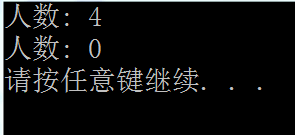C++ 继承
C++——继承
一、基本介绍
有些类与类之间存在特殊的关系
有些类之间拥有一样的性质,但是各自又拥有只属于自己的特性。
在这个时候我们可以使用继承,来减少重复代码。
二、继承的基本语法
语法: class 子类 : 继承方式 父类
父类:包含子类要继承的部分
子类中的成员,包含两大部分:
一类是从父类继承来的,一类是自己增加的成员。
从基类继承过来的表现其共性,而新增的成员表现其特性。
代码示例:
class Base
{
public:
int i = 1;
};
class Derive:public Base
{
public:
int b = 2;
};
程序写的很简单,但清楚地表现了继承的基本用法。
三、继承方式
继承方式一共有三种:
1.公共继承(public)
2.保护继承(protected)
3.私有继承(private)
下面我们用例子来了解三种继承方式的不同。
1.公共继承
| 基类成员访问属性 | 派生类成员访问属性 |
|---|---|
| private | 无法访问 |
| protected | protected |
| public | public |
class Base
{
public:
Base(int a = 0, int b = 0, int c = 0)
: _pub(a)
, _pro(b)
, _pri(c)
{}
int _pub = 1;
protected:
int _pro = 2;
private:
int _pri = 3;
};
class Derive :public Base
{
public:
void display()
{
cout << "_pub" << _pub << endl;
cout << "_pro" << _pro << endl;
cout << "_pri" << _pri << endl;
}
};
在public继承中,派生类访问基类的private成员时就会报错。
2.保护继承
| 基类成员访问属性 | 派生类成员访问属性 |
|---|---|
| private | 无法访问 |
| protected | protected |
| public | protected |
class Base
{
public:
Base(int a = 0, int b = 0, int c = 0)
: _pub(a)
, _pro(b)
, _pri(c)
{}
int _pub = 1;
protected:
int _pro = 2;
private:
int _pri = 3;
};
class Derive :protected Base
{
public:
void display()
{
_pro = 10;
}
};
int main()
{
Derive d1;
d1._pub = 4;
d1._pro = 5;
d1._pri = 6;
return 0;
}
在protected继承中在派生类中可以访问基类中的protected成员,但是在main函数中pub和_pro都不能被访问了,如果想要成员能在函数内部被访问,在函数外面不能被访问就用protected继承。
3.私有继承
| 基类成员访问属性 | 派生类成员访问属性 |
|---|---|
| private | 无法访问 |
| protected | private |
| public | private |
class Base
{
public:
Base(int a = 0, int b = 0, int c = 0)
: _pub(a)
, _pro(b)
, _pri(c)
{}
int _pub = 1;
protected:
int _pro = 2;
private:
int _pri = 3;
};
class Derive :private Base
{
public:
void display()
{
_pub = 20;
_pro = 10;
_pri = 30;
}
};
int main()
{
Derive d1;
d1._pub = 4;
d1._pro = 5;
d1._pri = 6;
return 0;
}
在私有继承中,从基类继承下来的东西全部就变为了派生类私有的,所以你在外部完全访问不了。
保护继承和私有继承的区别:
如果再次创建一个派生类来访问它的protected成员时是可以访问的,但是private成员就访问不了
四、继承种类
继承种类有两种,单继承和多继承。
1.单继承
单继承:一个子类只有一个父类。
示例:
#include<iostream>
using namespace std;
class Base
{
public:
int i = 1;
};
class Derive:public Base
{
public:
int b = 2;
};
int main()
{
Derive d1;
cout << sizeof(d1) << endl;
return 0;
}
单继承的格式:
class 派生类名:继承方式 基类名
{
派生类成员
};
2.多继承
多继承:一个子类可以有多个父类。
示例:
class Base1
{
public:
int a = 1;
};
class Base2
{
public:
int b = 2;
};
class Derive:public Base1, public Base2
{
int c = 3;
};
多继承的格式:
class 派生类名:继承方式 基类名,继承方式 基类名
{
派生类成员;
};
五、继承中的构造与析构
#include <iostream>
using namespace std;
class Object
{
public:
Object(const char* s)
{
cout<<"Object()"<<" "<<s<<endl;
}
~Object()
{
cout<<"~Object()"<<endl;
}
};
class Parent : public Object
{
public:
Parent(const char* s) : Object(s)
{
cout<<"Parent()"<<" "<<s<<endl;
}
~Parent()
{
cout<<"~Parent()"<<endl;
}
};
class Child : public Parent
{
protected:
Object o1;
Object o2;
public:
Child() : o2("o2"), o1("o1"), Parent("Parameter from Child!")
{
cout<<"Child()"<<endl;
}
~Child()
{
cout<<"~Child()"<<endl;
}
};
void run05()
{
Child child;
}
int main05(int argc, char *argv[])
{
cout<<"demo05_extend_construct_destory.cpp"<<endl;
run05();
system("pause");
return 0;
}
原则:先构造父类,再构造成员变量、最后构造自己
先析构自己,在析构成员变量、最后析构父类
//先构造的对象,后释放
六、继承中的作用域
(1) 在继承体系中基类和派生类都有独立的作用域。
(2) 子类和父类中有同名成员,子类成员将屏蔽父类对同名成员的直接访问,这种情况叫“隐藏”,也叫“重定义”(在子类成员函数中,可以使用 基类::基类成员 显示访问 )
(3) 需要注意的是如果成员函数的隐藏,只需要函数名相同就构成了隐藏。
(4) 注意:在实际工程中,继承体系里最好不要定义同名成员。
class Person
{
protected:
string _name = "小李子"; //姓名
int _num = 111; //身份证号
};
class Student :public Person
{
public:
void Print(){
cout << "姓名: " << _name << endl;
cout << "身份证: " << Person::_num << endl;
cout << "学号: " << _num << endl;
}
protected:
int _num = 999; //学号
};
void Test()
{
Student s1;
s1.Print();
}
七、继承与友元
友元关系是不能继承的,也就是说基类友元不能访问子类私有和保护成员。
实例验证:
#include <iostream>
#include <string>
#include <stdlib.h>
using namespace std;
class Person
{
public:
friend void Display(const Person& p, const Student& s);
protected:
string _name; //姓名
};
class Student :public Person
{
protected:
int _stuNum; //学号
};
void Display(const Person& p, const Student& s)
{
cout << p._name << endl; //error
cout << s._stuNum << endl; //error
}
int main()
{
Person p;
Student s;
Display(p, s);
return 0;
}
运行这段代码,会报错。
八、继承与静态成员
如果基类定义了static静态成员,则整个继承体系里只有一个这样的成员。无论派生出多少个子类,都只有一个static成员实例。
#include <iostream>
#include <string>
#include <stdlib.h>
using namespace std;
class Person
{
public:
Person(){
++_count;
}
protected:
string _name; //姓名
public:
static int _count; //统计人数
};
int Person::_count = 0;
class Student :public Person
{
protected:
int _stuNum; //学号
};
class Graduate : public Student
{
protected:
string _seminarCourse; //研究科目
};
void TestPerson()
{
Student s1;
Student s2;
Student s3;
Graduate s4;
cout << "人数: " << Person::_count << endl;
Student::_count = 0;
cout << "人数: " << Person::_count << endl;
}
int main()
{
TestPerson();
system("pause");
return 0;
}
运行结果:







